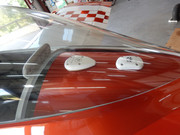Okay, this is from the Garmin STC for GPS antennas:
To achieve the best possible low-elevation antenna gain (by minimizing pattern degradation due
to shadowing and near-field interaction), the GPS antenna shall be mounted with clearance from
other antennas, including passive antennas such as another GPS antenna or XM antenna. When
practical, installers shall use 12 inch center-to-center spacing between antennas. If 12 inch
spacing is not practical, installers shall use the maximum center-to-center spacing from adjacent
antennas, but never less than 9 inch center-to-center spacing. Spacing less than 9 inches center-
to-center results in unacceptable GPS/WAAS antenna pattern degradation.
But there's a preamble to that section, which says:
The installation guidelines presented here meet the intent of AC 20-138A section 16. The greater the variance
from these guidelines, the greater the chance of decreased antenna performance. Approach procedures
with vertical guidance are the most sensitive to these effects. LNAV only approaches, terminal
operations, and enroute operations may also be affected. Because meeting all of these installations
guidelines may not be possible on all aircraft, these guidelines are listed in order of importance to achieve
optimum performance. Items 3a, 3b, and 3c below are of equal importance and their significance may
depend on the aircraft installation. The installer should use their best judgment to balance the installation
guidelines.
The separation guidance is in item 3 out of 4 under that preamble, so it isn't the most important. The preamble also allows for the existence of variance, and best judgement of the installer is allowed.
From looking at it, I would say real world antenna dimensions would affect the possibility of shadowing, as I alluded to earlier. The teardrop antenna has a higher vertical profile than the ARINC 743 antenna, so it would presumably present a higher probability of shadowing. Also keep in mind this guidance is only specifically designed for separation between Garmin GA 35, 36, and 37 antennas. It doesn't cover antennas from different manufacturers. I don't know what antenna Cap_Ax is using for his Dynon (the GPS-2020 presumably), so it's questionable how much that guidance applies. He may not even be using a GA 35, 36, or 37 antenna for his Garmin. He didn't say. New Zealand also doesn't have WAAS, which these antennas are designed for, and WAAS considerations may have something to do with the conditions in their separation guidance.
All of that is why I would still just continue as Cap_Ax is doing right now, were I in his shoes, and just make changes if the subsequent operational tests indicated a need for them. I would consider the ground test just a preliminary though, just to provide a better comfort level and to allow changes when it's easier to make them. The final decision would only be made with inflight testing after the full install, to ensure shadowing doesn't present a problem. But that's just me. And what do I know? I'm just a homebuilder. YMMV.
New Zealand only has a little over 40 STCs, and none are for Cessna or Garmin products, nor are any antenna specific. How manufacturer STCs produced for the US do or do not affect installations in New Zealand, I have no clue. I'm somewhat sure AC 20-138A section 16 doesn't apply there either, though I assume they have some similar regulation. That's why I made the disclaimer above. I have a hard enough time figuring out US restrictions and how they apply. I won't attempt to do that for New Zealand.
 .
.
